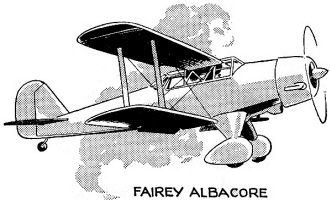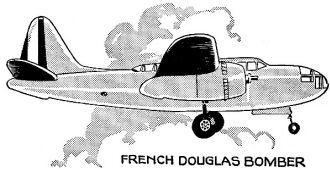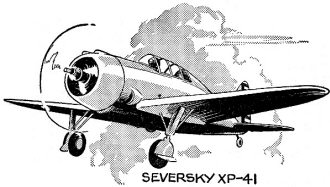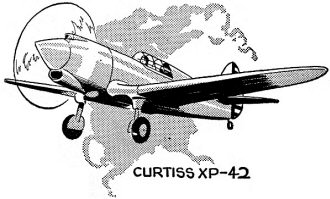|
"...the new World War has
clamped down the screens of censorship, hence we shall be lucky to get anything
much in the way of info and pictures on new equipment to be used by the warring
nations." That appeared in the December 1939 issue of Flying Aces magazines.
Most people here in America think of
World War II beginning
on December 7th, 1941, with the Japanese attack on Pearl Harbor. In actuality, the
war began much sooner with
Hitler's and Hirohito's
invasions in Europe (and North Africa) and Asia (South China and South Pacific),
respectively. The accepted start date is September 1, 1939, following Hitler's
invasion of Poland. Since a December magazine issue typically went to press in October
or October, the war had only begun a month or two earlier. Of particular interest
here (to me, anyway) is the Curtiss
XP−42, obviously a modification
of the P−40 Warhawk, but with a noticeably different cowl. Its shape suggests an
inline type engine, but reportedly it housed a
Pratt &
Whitney Twin Wasp radial.
Modern Planes Album
Four of the Latest War Machines
On our fighting craft menu this month: Britain's new all-purpose sea job, France's
American-built bomber which has already seen action, and two striking U.S. pursuit
planes - the new Seversky and Curtiss fighters.
Fairey Albacore
 This in all probability will be
the last of the new British service planes to appear in these or any other pages
for some time. For the new World War has clamped down the screens of censorship,
hence we shall be lucky to get anything much in the way of info and pictures on
new equipment to be used by the warring nations. This in all probability will be
the last of the new British service planes to appear in these or any other pages
for some time. For the new World War has clamped down the screens of censorship,
hence we shall be lucky to get anything much in the way of info and pictures on
new equipment to be used by the warring nations.
Last of the jobs to slip through this barrier, the Albacore appeared in the British
prints on August 17. We've only seen one photograph of it so far.
Manufactured by the Fairey Aviation Corporation of Hayes, Middlesex, England,
it's listed by the firm as a three-seat biplane dive-bomber likewise designed for
reconnaissance, torpedo, and aircraft carrier work - which is plenty for any machine.
It's obvious, of course, that they've attempted to turn out a craft fitting a multitude
of purposes. How well they have succeeded will only be known when they actually
try it out against the enemy.
In general, this biplane jack-of-all-trades will be used by the Fleet Air Arm
as a ship-board machine. It is powered with the new Bristol Taurus sleeve-valve
power plant and is fitted with either the Rotal airscrew or the De Havilland constant-speed
prop. We also notice that in the first two Albacores built there were several changes
in the design of the engine cowling. Then the fixed undercarriage was fitted with
streamline spats in the second model.
The interesting feature of this job is its negative overhang, meaning that its
lower wing has a greater span than the upper. This may be due to the fact that the
Albacore (that name means a young camel, cow, or heifer) will use special flaps
to control the speed while diving - a point that has caused several British experts
to raise their eyebrows. The plane can also be produced as a float seaplane. Unfortunately
we have no details on the armament, speed, or general performance.
French Douglas Bomber DB-7
 During the first week of the present Second
World War, the French Air Force enjoyed decided supremacy over the German airmen
who attempted to cover the ground activity about Hitler's West Wall. As a matter
of fact, the French bombers were skating all over the skies and were shooting down
German Army-Cooperation planes with comparative ease, while bombing the German defenses
into the bargain. During the first week of the present Second
World War, the French Air Force enjoyed decided supremacy over the German airmen
who attempted to cover the ground activity about Hitler's West Wall. As a matter
of fact, the French bombers were skating all over the skies and were shooting down
German Army-Cooperation planes with comparative ease, while bombing the German defenses
into the bargain.
This was somewhat contrary to what was generally expected, for France was supposed
to be quite tardy as far as air power was concerned. Her high degree of efficiency
developed during and after the World War had been allowed to crumble during a rather
soupy political regime which included an attempt to nationalize the. aircraft industry.
But when the story of these recent French air successes came out, it developed
that most of this air offensive was being carried out with bombers designed and
built in the United States. To be sure, they only had two of these new Douglas DB-7's-jobs
shipped over from this country before the neutrality law went into effect. But it
seems that those two proved very handy.
The new Douglas DB-7, as designed expressly for the French Air Service, is rated
at well over 300 m.p.h. carrying two 900-h.p. Twin-Wasp SC3-G engines, they appear
to be faster and more formidable than the highly touted German Junkers, Dorniers,
and Heinkels.
This is the first actual war-service machine to be fitted with a tricycle undercarriage.
The front wheel and the main portions of the undercarriage system retract into the
nose. The engines are carried in nacelles which are streamlined to a point well
behind the trailing edge of the wing. There appears to be a gunner's tunnel fitted
under the tail assembly.
The nose carries a compete gunner's cockpit, plus a prone-position turret for
the bomber-officer. There are complete navigation and engineer's compartments in
the fuselage, as well as modern enclosed bomb traps.
Seversky XP-41
 We are thankful that at last some American
manufacturers are really presenting something new for us to write about. We are thankful that at last some American
manufacturers are really presenting something new for us to write about.
At the present time the trend is to high-speed fighters rated in the 400-m.p.h.
class, although of course much of it is very hush-hush and you have to write your
own performance figures.
For instance we have a new Severky listed as the XP-41 and powered with a P. &
W. twin-row radial said to turn out more than 1,000 h.p. At present this machine
is undergoing service tests at Wright Field, so only the test pilots and the superior
officers know just what she will do under normal military conditions and with full
fighting loads.
This plane is not a great deal unlike the special racers that have been made
by the Seversky firm and flown by such noted National Air Race pilots as Frank Fuller
and Miss "Jackie" Cochrane. The original XP-41, by the way, was flown by Frank Sinclair,
Seversky test pilot. It caught fire in mid-air and crashed, Sinclair having taken
to his chute. This new model no doubt has had a lot of the "bugs" ironed out.
Generally speaking, it's a low-wing fighter monoplane with typical deep-bellied
fuselage. It has an undercarriage which folds upward and inward, giving the plane
a wide landing track. The cockpit, covered with some form of unbreakable transparent
hatch, is heated for high altitude flying. The equipment includes a modern engine
supercharger, oxygen equipment, and two-way radio set. The machine is all-metal
and covered with sheet Alclad, which presents a very smooth surface, with headless
rivets used.
Less powerful prototypes of this model have been reported to do well over 300
m.p.h. and it is within reasonable assumption that these new machines may get up
somewhere near the 400-m.p.h. mark, which no doubt will satisfy the high-speed school
of thought - especially if the XP-41's need not be flown in formation.
Details of the armament are not as yet known, but it will carry at least two
machine guns in the wings plus two on the engine cowl.
Curtiss XP-42
 Gradually the P-40 numbers are climbing.
Not so long ago the P-35 and the P-36 were top rung. Now we are up to the P-42,
which indicates how many models we actually pass over before we find a winner. Gradually the P-40 numbers are climbing.
Not so long ago the P-35 and the P-36 were top rung. Now we are up to the P-42,
which indicates how many models we actually pass over before we find a winner.
This latest Curtiss single-seat fighter is now at Wright Field, where the Air
Corps test pilots are "trying to take her apart." Another all-metal low-wing monoplane,
this model is designed for modern tactical exercises and as service equipment. The
front view of it should especially interest our readers, who may get a first impression
that the plane is fitted with some sort of an in-line chemical-cooled power plant.
The cowling appears, at first glance, to cover an Allison engine. The large prop-boss
makes the mystery even more puzzling.
Actually, the engine is a twin-row Pratt and Whitney Wasp rated at 1,200 h.p.
The designers, we understand, have devised a cowling to cover such a motor and yet
achieve the streamlined effect of the type of cowling usually found over an in-line
engine. This, of course, accounts for the large spinner cap, devised to cover the
space between the prop boss and the front ring of the engine cowling. Several reports
on this plane have it that it is powered with the 1,250-h.p. Allison - but this
is not true, for we of Flying Aces have tracked the power plant down. That it's
a Wasp has been confirmed by P.&W.
Truly, the makers have attained a splendid streamline effect, and we see no reason
why they should not get the same performance from a plane powered with the noted
radial engine as they might do with a streamlined in-line engine. The reader may
observe the radial air-scoop orifices, and in later pictures we have noticed adjustable
cooling gills at the back of the engine cowling.
Posted August 20, 2022
|